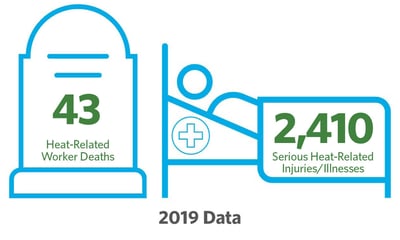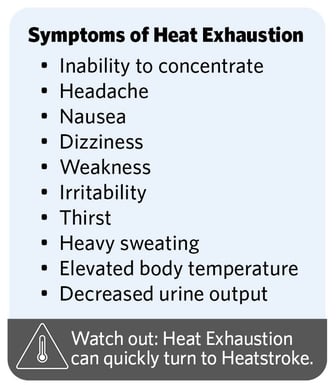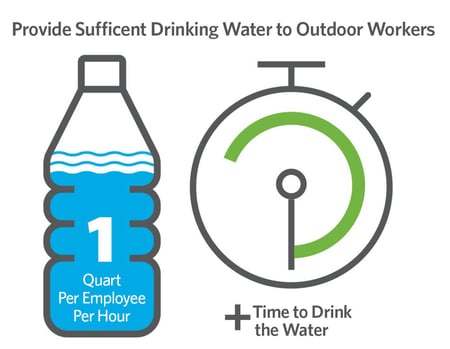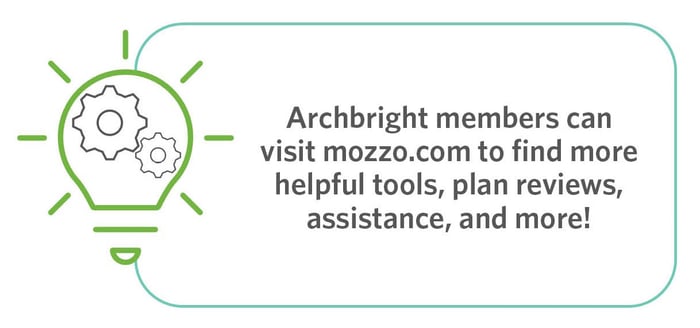Navigating Federal and State-Required Heat Prevention Plans
NASA's Goddard Institute for Space Studies (GISS) scientists reported that July 2023 was the hottest month on record globally. Unfortunately, experts...
5 min read
 Tiffany Knudsen, SMS
:
May 2, 2022 3:10:17 PM
Tiffany Knudsen, SMS
:
May 2, 2022 3:10:17 PM

With summer temperatures consistently rising across the country year after year, new safety regulation development is underway at the state and federal levels to prevent work-related heat stress illnesses and injuries.
Last year, the Occupational Health and Safety Administration (OSHA) began initiating enhanced measures to better protect workers from hot work environments and reduce the dangers of exposure to ambient heat. OSHA stated that while heat illnesses are largely preventable and commonly underreported, thousands of workers are sickened each year in the US from workplace heat exposure.
 Even with under-reporting, in 2019, 43 workers are known to have died from heat illness, and at least 2,410 others suffered from serious heat-related injuries and illnesses. In addition to the impact of these types of incidents on workers, there are also financial effects felt by employers due to lost productivity and increased workers’ compensation costs. The Atlantic Council’s Adrienne Arsht-Rockefeller Foundation Resilience Center estimates the economic loss from heat to be at least $100 billion annually—a number that could double by 2030 and quintuple by 2050 under higher global climate emission scenarios.
Even with under-reporting, in 2019, 43 workers are known to have died from heat illness, and at least 2,410 others suffered from serious heat-related injuries and illnesses. In addition to the impact of these types of incidents on workers, there are also financial effects felt by employers due to lost productivity and increased workers’ compensation costs. The Atlantic Council’s Adrienne Arsht-Rockefeller Foundation Resilience Center estimates the economic loss from heat to be at least $100 billion annually—a number that could double by 2030 and quintuple by 2050 under higher global climate emission scenarios.
Employers may find it helpful to understand what heat stress is and how it can impact workers. The first thing to know is that all workers exposed to extreme heat or even just warm environments are at risk of heat stress. Heat stress occurs when the body cannot rid itself of excess heat. When this happens, the body’s core temperature and heart rate increase, resulting in several different conditions such as heat rashes, heat cramps, heat exhaustion, or heat stroke. Burns may also occur due to accidental contact with hot surfaces or steam.
Heat rashes are skin irritation caused by excessive sweating during hot, humid weather. They typically look like red clusters of pimples or small blisters and can appear on the neck, upper chest, groin, under the breast, and elbow creases.
Heat cramps usually affect workers who sweat excessively during strenuous activity, causing a depletion of the body’s salt and moisture levels. The depleted salt levels in the muscles lead to painful cramps or spasms, typically in the abdomen, arms, or legs.  Heat exhaustion is the body’s response to an excessive loss of water and salt, usually through heavy sweating. Employees can experience heat exhaustion when temperatures rise, when they wear heavy gear, or even when they are performing strenuous work in warm environments. When the individual can’t effectively cool down by sweating, resting in a cool environment, or removing gear, they can begin to lose the ability to concentrate, finding basic tasks difficult. Other symptoms of heat exhaustion include headache, nausea, dizziness, weakness, irritability, thirst, heavy sweating, elevated body temperature, and decreased urine output. If not addressed, heat exhaustion can quickly turn to heatstroke.
Heat exhaustion is the body’s response to an excessive loss of water and salt, usually through heavy sweating. Employees can experience heat exhaustion when temperatures rise, when they wear heavy gear, or even when they are performing strenuous work in warm environments. When the individual can’t effectively cool down by sweating, resting in a cool environment, or removing gear, they can begin to lose the ability to concentrate, finding basic tasks difficult. Other symptoms of heat exhaustion include headache, nausea, dizziness, weakness, irritability, thirst, heavy sweating, elevated body temperature, and decreased urine output. If not addressed, heat exhaustion can quickly turn to heatstroke.
Heatstroke is the most serious heat-related illness. It occurs when the body can no longer control its temperature and its sweating mechanism fails. When this happens, the body cannot cool itself down, and its temperature can rise to 106°F or higher in 10 to 15 minutes. In this situation, the worker may become irritable or sick, and their speech slurred. If symptoms are not addressed immediately, the person can faint, seize, suffer permanent disability, or in extreme cases, the situation can become fatal.
In the fall of 2021, OSHA announced plans to create a permanent safety standard to address the hazards associated with heat-related injuries and illnesses. Although the proposed rule is still under review, OSHA has announced the implementation of a new National Emphasis Program (NEP) related to heat illnesses and injuries for workers. This heat-related NEP will concentrate on heat-related ailments such as heat stroke, heat exhaustion, heat cramps, heat syncope (fainting), heat rash, rhabdomyolysis (muscle breakdown), and acute kidney injury. The NEP will also focus on injuries related to heat exposure, such as a fall or cut that occurs during or after heat exposure.
Until a permanent standard is in place, the heat-related NEP will be enforced under the General Duty Clause, which states that employers must provide a work environment free from recognized hazards that are causing or likely to cause death or serious physical harm. This means that employers should address heat-related exposures as they would any other hazard in the workplace by taking measures such as:
In Washington, employers must follow the safety planning, training, and other requirements outlined in the state’s current Outdoor Heat Exposure rule, WAC 296-62-095. This rule applies to workers who perform job duties outdoors for more than 15 minutes in any 60-minute period, from May 1 through September 30, and are exposed to outdoor heat at or above the applicable temperatures listed below:
| When wearing nonbreathing clothes, including vapor barrier clothing or PPE such as chemical resistant suits | 52° |
| When wearing double-layer woven clothes, including coveralls, jackets, and sweatshirts | 77° |
| When wearing all other clothing | 89° |
Affected employers must address heat exposure in their Accident Prevention Program. They must train workers and their supervisors in a language that they understand on the different types of heat stress, including signs and symptoms, environmental and personal factors that may impact the individual, and how to address heat-related illnesses.
Employers must also provide a sufficient quantity of drinking water to outdoor workers, typically at least one quart of water per employee per hour, as well as the opportunity to drink the water. Some employers may also provide electrolyte beverages or popsicles to supplement the water supply on extra hot days. In addition to water, employers need to allow workers to take breaks in a cool area and, when possible, schedule strenuous work during cooler parts of the day or even reschedule more labor-intensive tasks to days forecasted to be cooler.
In addition to the current rule, in July 2021, the Department of Labor & Industries (L&I) issued emergency temporary rules to address extreme high-heat procedures with requirements for mandatory preventive cool-down rest periods. These rest periods must include specific amounts of shade and cooling stations such as air-conditioned trailers or misting tents when temperatures reach 100°F. L&I has announced that they will incorporate the emergency temporary rules into the permanent standard and issue an updated permanent rule as early as June 2022. Until then, Washington employers must follow both sets of standards.
In Oregon, the Heat Illness rule 437-002-0155 applies when the heat index equals or exceeds 80°F and employees are performing work activities in these environments for more than 15 minutes in any 60-minute period and are not otherwise covered under another regulation such as Wildland Fire Suppression.  Some of the requirements outlined in the general heat illness rule include acclimatizing workers to the hot work environment, providing 32 ounces of cool drinking water per hour, access to shade, and training on heat illnesses and prevention in a language understood by the worker. The employer must provide the training before the employee begins working in the hot environment. Oregon requirements provide more detail on how employers must provide the shade to employees. Tents or trailers can be utilized but must be open-air or have mechanical cooling and be large enough to accommodate the number of employees recovering during rest periods or meal periods. The shaded area must also allow the workers to sit in a normal posture and be located as close as practical to the work area. There are limited exemptions to the shade requirements, including during high wind or situations where an employee walks through rangeland. Rangelands are grasslands, shrublands, woodlands, wetlands, and deserts grazed by domestic livestock or wild animals. Employers must provide alternative cooling measures equally preventative in these locations.
Some of the requirements outlined in the general heat illness rule include acclimatizing workers to the hot work environment, providing 32 ounces of cool drinking water per hour, access to shade, and training on heat illnesses and prevention in a language understood by the worker. The employer must provide the training before the employee begins working in the hot environment. Oregon requirements provide more detail on how employers must provide the shade to employees. Tents or trailers can be utilized but must be open-air or have mechanical cooling and be large enough to accommodate the number of employees recovering during rest periods or meal periods. The shaded area must also allow the workers to sit in a normal posture and be located as close as practical to the work area. There are limited exemptions to the shade requirements, including during high wind or situations where an employee walks through rangeland. Rangelands are grasslands, shrublands, woodlands, wetlands, and deserts grazed by domestic livestock or wild animals. Employers must provide alternative cooling measures equally preventative in these locations.
Similar to federal OSHA and Washington, in July 2021, Oregon adopted two emergency temporary rules—one for agriculture and another for all other workplaces that further specifies actions to be taken as temperatures rise. Key requirements addressed in these temporary standards are the need to keep drinking water cool (temperatures ranging from 35° to 77°F), that any packaged water or electrolyte-replenishing drinks do not contain caffeine, that employers monitor workers for signs of heat illness, and that supervisors maintain effective communication with workers. When temperatures exceed 90°F, employers also must implement an Emergency Medical Plan that includes medical and first aid procedures for heat-related incidents.
While OSHA and states with heat exposure requirements provide sample written programs and training materials, employers still need to update the templates to reflect the hazards of their worksites. Archbright members can find helpful tools such as a Heat Exposure Plan and Heat Exposure Quickstart in the Resource Library on mozzo and have access to Archbright’s Safety Consultants for plan reviews, assistance with training implementation, and more.

.jpg)
NASA's Goddard Institute for Space Studies (GISS) scientists reported that July 2023 was the hottest month on record globally. Unfortunately, experts...

Nestled in the Pacific Northwest, Washington State is known for its temperate climate. However, that doesn’t mean the region doesn’t experience hot...

Do your employees work from heights in the state of Washington? If so, you may need to brush up on the Washington Labor and Industries’ (L&I) updated...